#mountain pacas
Text

Grzimek's Animal Life Encyclopedia, vol. 11, Mammals II. 1972. Illustrated by Peter Barrett.
1.) Patagonian mara (Dolichotis patagonum)
2.) Chacoan mara (Dolichotis salinicola)
3.) Capybara (Hydrochoerus hydrochaeris)
4.) Pacarana (Dinomys branickii)
5.) Mountain paca (Cuniculus taczanowskii)
6.) Lowland paca (Cuniculus paca)
7.) Red acouchi (Myoprocta acouchy)
8.) Black agouti (Dasyprocta fuliginosa)
9.) Red-rumped agouti (Dasyprocta leporina)
#rodents#patagonian maras#chacoan maras#capybaras#pacaranas#mountain pacas#lowland pacas#red acouchi#black agoutis#red-rumped agoutis#Peter Barrett
352 notes
·
View notes
Text









THE MOUNTAIN GOATS // THE LAST DAYS OF JUDAS ISCARIOT
Liza Forever Minelli - Brandy Let's Go - Have to Explode - Alpha Incipiens - All Hail West Texas liner notes
#she was my poem mr iscariot *starts fortnite dancing*#anyway this post is dedicated to paca. insanity#the mountain goats#the last days of judas iscariot#john darnielle#jesus#judas#judas iscariot#theater#uhh. whatever. yeah#post
338 notes
·
View notes
Text
John Rambo never went to Vietnam
9 notes
·
View notes
Photo

Somewhere in Provence Caseneuve to be exact #lifestrails #adventurecreatively #provence #caseneuve #france #lavender #farm #sunset #PACA #Beautifuldestinations #vacations #discover #explorepage #exploremore #explore #mountains #photography #europe #europetravel #thegreatoutdoors #outdoor #outside #gooutside #forest #photography #photooftheday #nature #vacation #travel #travelgram (at Caseneuve) https://www.instagram.com/p/ChVnH6PMaC3/?igshid=NGJjMDIxMWI=
#lifestrails#adventurecreatively#provence#caseneuve#france#lavender#farm#sunset#paca#beautifuldestinations#vacations#discover#explorepage#exploremore#explore#mountains#photography#europe#europetravel#thegreatoutdoors#outdoor#outside#gooutside#forest#photooftheday#nature#vacation#travel#travelgram
0 notes
Text

For the Piaroa Indians, the original inhabitants of the area, Autana is a sacred mountain (Wahari-Kuawai in the Piaroan language). It is Kuaimayojo, the stump of ‘the sacred tree of the fruits of the world’. Piaroan mythology tells how ‘-the tree-top went as high as the infinite, and its branches were full of fruits which fell and gave life to the Amazon’. One day Wahari (a God) and his nephew Ruayei, which had been transformed into a lapa (Cuniculus paca), cut down the tree to get all the fruits at once.
Image : Cerro Autana, Venezuela
42 notes
·
View notes
Text
Section 7 / Continent: South America
General Layout:
Section 7 is set up in a dense jungle with large rivers cutting through it. The majority of the section is enclosed due the its density, and the few clearings that the section has are used for buildings.
The section is marked with pathways, and there are stairs, escalators, elevators that take you up into the trees and bridges that take you across. Guests can also get around the section riding up and down the rivers in small boats.
There's also a wide variety of restaurants, gift shops, and amenities, within the section, including guided jungle expeditions, outdoor rope courses, and wild cat cafes.
The Animals:
Amphibians: Frogs.
Aquatic/Semi-Aquatic Mammals: Capybaras, Elephant Seas, Otters, Sea Lions
Birds: Boobies, Caracaras, Doves, Egrets, Finches, Flamingos, Hawks, Herons, Kiskadees, Lapwings, Owls, Parrots, Sparrows, Spoonbills, Swans, Toucans, and Vultures
Fish: Angelfish, Butterflyfish, Damselfish, Eels, Morays, Parrotfish, Pufferfish, Seahorses, Surgeonfish, Tangs, and Trumpetfish.
Insects: Bees, Beetles, Butterflies, Dragonflies, Grasshoppers, and Mantises.
Misc. Carnivores Animals: Anteaters, Bats, Jaguars, Jaguarundis, Mountain Lions, and Ocelots.
Misc. Herbivorous Animals: Agoutis, Coypus, Deer, Guanacos, Guinea Pigs, Kinkajou, Llamas, Maras, Pacas, Porcupines, Sloths, Tapirs, and Vicuñas, and Viscachas.
Misc. Omnivorous Animals: Alpacas, Armadillos, Bears, Coatis, Foxes, Maned Wolves, Opossums, Peccaries, Racoons, Skunks, Squirrels, and Tayras.
Primates: Capuchins, Howler Monkeys, Marmoset, Squirrel Monkeys, Tamarins, Titis, and Woolly Monkeys.
Reptiles: Caimans, Lizards, Snakes, and Turtles.
#the butterfly's effect#notes#writers on tumblr#current wip#writeblr#writblr#writers#writing#wip#work in progress#zoo#wildlife#south america#south american wildlife#american fauna#american animals#american wildlife
2 notes
·
View notes
Text
Rodent Competition 2023
Round 1

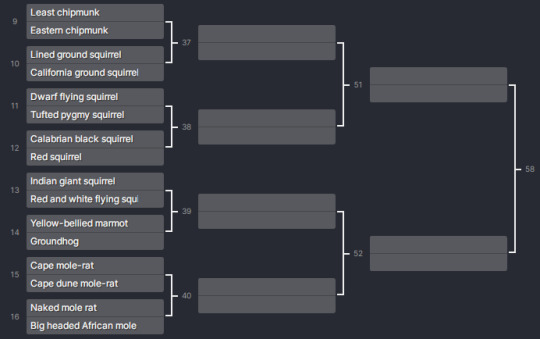
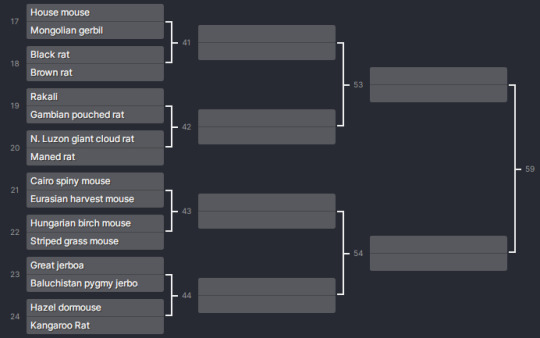

full list below!
Long-tailed chinchilla / Southern viscacha
Common degu / Horned gopher
Common gundi / Guinea pig
Josephoartigasia monesi / Pacarana
Patagonian mara / South African springhare
Spix's yellow-toothed cavy / Capybara
Central american agouti / Lowland paca
Laotian rock rat / Dassie rat
Least chipmunk / Eastern chipmunk
Thirteen-lined ground squirrel / California ground squirrel
Japanese dwarf flying squirrel / Tufted pygmy squirrel
Calabrian black squirrel / Red squirrel
Indian giant squirrel / Red and white giant flying squirrel
Yellow-bellied marmot / Groundhog
Cape mole-rat / Cape dune mole-rat
Naked mole rat / Big headed African mole rat
House mouse / Mongolian gerbil
Black rat / Brown rat
Rakali / Gambian pouched rat
Northern Luzon giant cloud rat / Maned rat
Cairo spiny mouse / Eurasian harvest mouse
Hungarian birch mouse / Striped grass mouse
Great jerboa / Baluchistan pygmy jerboa
Hazel dormouse / Kangaroo rat
Grasshopper mouse / Winter white dwarf hamster
Hatt's vesper rat / Syrian hamster
Norway lemming / Florida Mouse
European water vole / Townsend’s vole
Northern mole vole / Muskrat
Bristle-spined rat / Mountain beaver
North American beaver / Palaeocastor
Crested porcupine / North American porcupine
#rodentcompetition2023#some changes might happen#mostly if I made some mistakes#but hopefully not!#here they are :D#some names in photos are shortened to fit#tournament poll#round 1
18 notes
·
View notes
Text
SOJIRO SAKURA (P5) PRNS && TITLES

Pronouns
cafe/cafes, coffee/coffees, bean/beans, coffee/beans, booth/booths, curry/curries, latte/lattes, aroma/aromas, grind/grinder, ground/grounds, powder/powders, le/leblanc, express/expresso, sugar/sugars, milk/milks, cream/creamer, black/blacks, black/coffee, brew/brews, roast/roasts, foam/foams, cocoa/cocoas, de/caf or de/decaf, study/studies, read/reads, cup/cups, le/lait (french for milk), blue/mountain, hard/bean, narino/narinos, crystal/mountain, kona/konas, mocha/mochas, mocha/harrar, mocha/matari, altura/alturas, typica/typicas, antigua/antiguas, paca/mara, kopi/kopis, luwak/luwaks, kopi/luwak, hiero/phant, arcana/arcanas, hierophant/arcana

Titles
The Small Café Owner, The Owner Of Leblanc, *He Who Watches Over The Unfortunate, The Fatherly* Figure Of The Phantom Thieves, He* Who Makes Delicious Curry, He* Who Runs A Small Café, The Chief, The Boss, The Guardian Of The Phantom Thieves, He* Who Protects His* Children, The Hierophant Arcana, The Adoptive Father*, The Cynical Café Owner, The Master Of Coffee && Curry, He* Who Houses The (Phantom Thief Leader / The Phantom Thieves), He* Who Regrets The Past, He* Who Vows To Protect Wakaba's Daughter

*can be replaced with any noun or pronoun! it is simply an exemplar based off of Sojiro.
#ִ ࣪𖤐 ; want me to kill? | asks#ִ ࣪𖤐 ; time to die! | requests#mogai#mogai blog#personagender#p5 sojiro#persona 5 sojiro#persona pronouns#pronouns#pronoun suggestions#pronoun help#pronoun list#persona titles#titles#title suggestions#title help#title list#persona kin#p5 kin#councilor anon
5 notes
·
View notes
Photo
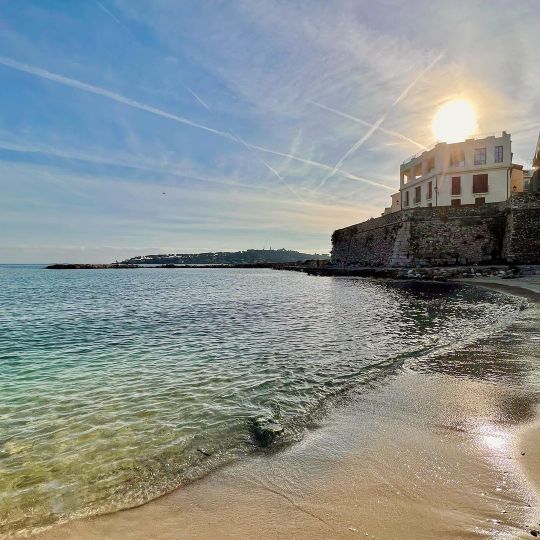
Antibes la belle ❤️ #hike #hiking #mountains #frenchriviera #adventure #cotedazur #france #seafront #beach #explore #nice #naturephotography #seaside #cannes #outdoors #sunset #southoffrance #nature #monaco #photography #hikingadventures #cotedazurfrance #brighton #paca #travel #wanderlust #montecarlo #naturelovers #seaview #mountain (à Antibes, Côte D'azur) https://www.instagram.com/p/Cmvhx2IoVKS/?igshid=NGJjMDIxMWI=
#hike#hiking#mountains#frenchriviera#adventure#cotedazur#france#seafront#beach#explore#nice#naturephotography#seaside#cannes#outdoors#sunset#southoffrance#nature#monaco#photography#hikingadventures#cotedazurfrance#brighton#paca#travel#wanderlust#montecarlo#naturelovers#seaview#mountain
3 notes
·
View notes
Text
weepingalpacafuneral -> dykedalecooper -> tkolrmx -> fogagainagain -> dykedalecooper
alpaca- if we’re friends, call me paca
he/her, it/its, or any pronouns
adult
don't use tone indicators with me
please dm me and send me asks and talk to me! i love talking to people
mutuals friend me on discord at weepingalpacafuneral
music blog/mountain goats @marywollstonecraftshelly
#about#words#art#steph tag#from the discord dms#comic book#music posts#lyrics posting#love#months#dog#animals#cats#comic book art#fav#women
7 notes
·
View notes
Text
Neptune Internet Services connecté à la montagne , à retrouver au salon Mountain Planet 2024 Stand 702
See on Scoop.it - Club euro alpin: Economie tourisme montagne sports et loisirs
Neptune Internet Services | 1,150 followers on LinkedIn. Notre expertise digitale à votre service | Acteur incontournable des solutions Wifi et Web pour les professionnels depuis plus de 25 ans, Neptune IS met ses compétences au service de plus de 500 entreprises et collectivités de la région Auvergne Rhône-Alpes et PACA.
Francis Fiesinger Pro's insight:
#neptuneInternetservices #wifi #montagne #web #internet présent au slon Mountain Planet Stand 702 #grenoblealpes #ccigrenoble
0 notes
Text




.
We have started roasting new coffee beans, "Guatemara - Geisha Washed".
新しくグアテマラ ゲイシャ種の焙煎をはじめました(いろいろあったので1年ちょっとぶりの自家焙煎 💦)✋
ーーーーー
ー
◼︎ GUATEMALA Finca El Pinal - Geisha Washed
FLAVOR NOTE: Jasmine, Bergamot, White peach, Almond praline, Japanese pepper, Silky mouthfeel, Elegant
.
VARIETY: Geisha
PROCESS: Washed
REGION: Jalapa - Jutiapa
PRODUCER: Abel Valladares
ALTITUDE: 1450 - 1500 m
.
Finca El Pinalは22年前に設立された家族経営の農園で、Geisha, Pacamara, Maracaturra, Pacasなどの品種の栽培に専念しています。
Abel Valladaresは農園をはじめる前、20年近くアドバイザーとして働き 1000ha以上の土地にコーヒーを植えてきました。しかし23年前 幸運にもMonjas Jalapaの小さな町に自分の土地を購入する機会があり、自らのコーヒー栽培をスタートすることになりました。
Finca El Pinalのコーヒー品質の秘密は、収穫からコーヒーチェリーの品質管理、保管まで、家族全員参加でプロセスに関与していることです。 Washedプロセスにこだわり、収穫後 選定されたチェリーは果肉を除去したのち48時間発酵させ ミューシレージを取り除いて 高床式のベッドに広げ 2週間かけてゆっくり乾燥させられます。
Geisha種は 野生のエチオピア原種を起源とする希少な古代コーヒーです。ジャスミンやベルガモット、日本人には山椒 を思わせる繊細なアロマから、ホワイトピーチのような優しい酸、プラリネのような香ばしい甘さに続いていきます。とても滑らかな口当たり 軽やかでエレガントな飲み心地のコーヒー。是非お試しください!
➖➖➖➖➖
☕️ Single Origin Coffee Line-up
[Single O]
C) RESERVOIR - Blend
T) KENYA Kahuhia FCS - Washed
T) BRAZIL Fazenda Santa Hedwirges - Natural
[Headlands Coffee]
N) COSTA RICA Don Sabino Micromill - SL28 Natural
C) Deadly Decaf Mexico(Mountain water process)
[B'R.U,T]
次回入荷を楽しみにしていてください
ー
Categories
T) The Specialty ...Terroir
C) Conceptual ...Sorting, Technology transfer
N) New Wave ...Innovative approach
S)) Special ...Winning lot, Top specialty
➖➖➖➖➖➖➖➖➖➖
FLOWER COFFEE / BREW BAR
Weekday 10:00 - 18:00
Weekend/ Holiday 9:00 - 17:00
店舗休: 10月 24日
.
※ 小さなお店ですので 団体��のご利用には向きません(状況に応じてテイクアウトでの対応とさせていただきます)
※ 安全面を考慮し 警戒レベル3以上の悪天候が見込まれる場合には予報に沿って営業スケジュールを調整します(なるべく早く店頭張り紙、SNS、Googleにて情報発信します)
ーーーーーーーーーー
神奈川県茅ヶ崎市東海岸北1-7-23 雄三通り
🚃 JR茅ヶ崎駅 歩8分
🚲 駐輪可 3台まで
🚗 駐停車不可(近隣駐車場をご利用ください、参考: 三井リパーク ¥200-/h)
🦠 周囲に配慮あるご利用をお願いいたします
ーーー
#thanxalways #newbeans #guatemala #jalapa #fincaelpinal #geisha #washed
.
#specialtycoffee #singleorigin #coffee #singleo #headlandscoffee #brutcoffee #hario #takahiro #mahlkonig #lamarzocco #pesado #kinto #sttoke #flowercoffeebb #everydaybeautiful #shonan #chigasaki #yuzostreet
1 note
·
View note
Text
Provence-Alpes-Côte d'Azur

Provence-Alpes-Côte d’Azur (or PACA) is one of the eighteen administrative regions of France, located in the southeast and encompassing six departments. This region of France has an incredibly diverse geography, bordered by Italy to the east and Monaco and the Mediterranean Sea to the south. PACA has over 5 million people, with Marseille being its largest city. With its temperate, early-summer climate and gorgeous variety of landscapes such as the Alps mountains and Mediterranean coastline, Provence-Alpes-Côte d’Azur has become a vacation destination for millions of tourists each year. This region is quintessentially French!
Language and Culture
Though French is, of course, the most spoken language in the region, there are many foreign and regional languages present as well. Those languages include Italian, Arabic, Spanish, Corsican, and Provençal, a regional language that combines elements of both French and Catalan, a regional language from eastern Spain.
PACA is one of France’s largest immigration hubs, welcoming immigrants from surrounding European and Mediterranean countries such as Spain, Portugal, Italy, Morocco, Algeria, and Tunisia. As a result, PACA’s culture is overwhelmingly Mediterranean. PACA is heavily urbanized as well, with approximately 90 percent of its population living in towns. PACA also has over 2,000 historical sites and monuments as well as several UNESCO World Heritage sites (which I discuss in further detail below). This region also boasts an incredible amount of festivals and major sporting events, such as the Cannes Film Festival and the Grand Prix.
Notable People
Some famous individuals from PACA include the prophet Nostradamus, the painter Paul Cézanne, and American-born singer Nina Simone.
UNESCO World Heritage Sites
Because there are dozens of UNESCO World Heritage Sites in Provence-Alpes-Côte d’Azur alone, I decided to focus on three in this blog: the Geopark of Haute-Provence, the Fortifications of Briançon, and Pays de Grasse.
The Geopark of Haute-Provence, located between the Alps and Provence, is the largest open-air geological museum in France. It houses 18 separate geological sites, such as the Dalle aux Ammonites (ammonite slab) which illustrates 200 million years of fossils and fascinating discoveries. The Geopark is perfect for students and people dedicated to preserving and protecting natural history!
Designed by Louis XIV’s famed military engineer, Vauban the Visionary, Briançon is a fascinating town in the Alps in PACA. It is a testament to France’s lengthy military history, with its elaborate forts, walkways, and slopes. Despite being closed to the general public, these forts can be accessed via private tours.
Finally, though Pays de Grasse is not a UNESCO World Heritage site in a traditional sense, this town is still hailed as a center of significant cultural importance in France. Grasse boasts some of the world’s most beautiful mimosa, violet, and jasmine fields, which are used in its world-renowned perfumery industry. Grasse’s spot as one of UNESCO’s “Intangible Cultural Heritage” sites is due to its centuries-long perfected perfume techniques, including plant growth, selection, and processing of raw materials.
Food
Provence-Alpes-Côte d’Azur hosts a strong, multinational cuisine, influenced by Italian, French, and Mediterranean foods. Some of its most famous dishes include ratatouille (a dish comprised of tomatoes, aubergine, garlic, onion, courgette, and capsicum); bouillabaisse (a classic fish soup made with seafood and a spicy broth); and pissaladière (an Italian-French-fusion flatbread that closely resembles pizza).
PACA is also France’s oldest wine-producing region; the first vines in France were said to have been grown around Marseilles in the 6th century BC! PACA is known in particular for its red and rose wines.
Sources

0 notes
Text
News from Marseille, France, 10 July.
Marseille is experiencing a heatwave with temperatures reaching up to 32°C, requiring precautions such as staying hydrated and using sunscreen.
Météo France has placed three departments in the Paca region (Alpes-de-Haute-Provence, Alpes-Maritimes, and Var) on orange heatwave alert, while Bouches-du-Rhône and Vaucluse are on yellow alert.
2. Two-year-old Emile disappeared from his grandparents' house in a village in the Alpes-de-Haute-Provence, and extensive search efforts are underway.
Concerns have been raised about the presence of wolves in the area, as volunteers fear that Emile may have fallen asleep and become vulnerable to them.
The search operation involves over 300 volunteers, including specialized mountain rescue teams, and the investigation is ongoing with all possible leads being explored.
3. A man was shot and killed in Hyères, Var, and three suspects were arrested in La Garde.
The prosecutor of Toulon stated that the investigation is currently focused on voluntary manslaughter by organized gang and that the suspects were found in possession of firearms.
The police will be working to unravel the complex sequence of events surrounding the crime.
4. The French government is providing support to businesses affected by recent riots in Marseille, including the possibility of canceling charges and implementing partial unemployment measures.
The Minister of Economy is calling for solidarity and understanding from insurers to expedite the claims process and reduce franchise amounts for small independent businesses.
Local institutions have allocated financial aid of up to 12 million euros to assist affected businesses, with the government urging a collective effort from insurers, banks, and local authorities to fully compensate for the damages.
5. The Aix-Marseille-Provence Metropolis is launching a new carpooling service called "Lecovoiturage" to encourage residents to use carpooling instead of driving alone.
The service will be operated in partnership with Karos, a specialized company with over 380,000 users in France, and will focus on the home-to-work commute.
The initiative will offer financial incentives for drivers who share their vehicle and a low fare of 0.50 euro per trip for passengers, with free carpooling for RTM subscribers.
6. The program "1,2,3, Nagez !" aims to provide free swimming lessons to children in underserved areas of France, with the goal of teaching over 20,000 children to swim this summer.
The program is supported by various partners, including Paris 2024, the National Sports Agency, the French Swimming Federation, EDF, the Department of Seine-Saint-Denis, and the city of Marseille.
7. There was concern among some residents and officials in Marseille that the exterior of the Vélodrome stadium would be labeled "Paris-2024" for the upcoming Olympic Games, but the organizing committee has assured that it is not mandatory.
The mayor's deputy, Samia Ghali, expressed that it would be poorly received by the people of Marseille to have "Paris" displayed on their iconic football stadium.
The organizing committee has stated that while the Vélodrome will be decorated in the Olympic look, they are open to adapting the design and ensuring the stadium remains personalized for the city.
#MarseilleHeatwave#TrafficControl#InfrastructureImprovements#MissingChild#WolfConcerns#CrimeNews#RiotSupport#CarpoolingService#SwimmingLessons#VelodromeControversy
0 notes
Text
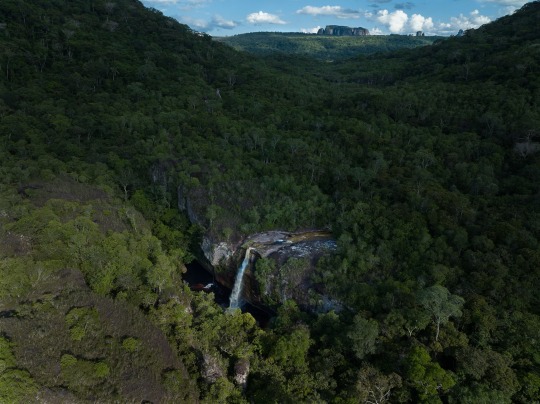
Chiribiquete National Park, the largest protected area in Colombia, is distinguished by its tepuis, tabletop peaks that rise abruptly from the rainforest. The area, with waterways that feed into the Amazon, is one of the world’s most biodiverse and is home to many unusual endemic species.
Rarely Seen Cliff Art Reveals The Majesty Of The Amazon’s Aquatic Realm
In a two-year expedition, a National Geographic photographer is documenting the mighty river and the greater ecosystem from the Andes to the Atlantic.
— Story and Photographs By Thomas Peschak | March 22, 2023
Two jaguars leap into the river, lunging at pacas. These oversize rodents, with blotched and striped coats, are agile swimmers. Piranhas, attracted by the commotion, hover nearby.
I’m photographing this riveting scene, but I’m not underwater as I usually am when I’m on assignment. Instead of diving to see this aquatic life, I’ve climbed to a rocky ledge far above a rainforest. The jaguars, pacas, and piranhas are not flesh and blood; they are prehistoric artworks painted with hematite, a blood-red iron oxide, in exquisite detail. I am in awe, as if seeing the ceiling of the Sistine Chapel for the first time.
These pictographs in Colombia’s Chiribiquete National Park, tens of thousands of years old, are evidence of humankind’s long relationship with the world’s greatest freshwater ecosystem. I’m part of the National Geographic and Rolex Perpetual Planet Amazon Expedition, working closely with other National Geographic Explorers doing critical research in the hope of securing the future of this watery realm, which has been neglected by science and the media.
The rainforests, an essential and endangered counterweight to climate change, have overshadowed the mighty river. From the Andes to the Atlantic, the Amazon flows for 4,150 miles, the main artery of a web with more than a thousand tributaries and tens of thousands of streams in an area the size of Australia. For two years, I will photograph the river, from high in the mountains to far out into the ocean. Unlike most storytellers who have ventured here, I will dive below the surface to reveal a rarely glimpsed aquatic underworld.

The National Geographic Society, committed to illuminating and protecting the wonder of our world, has funded Explorer Thomas Peschak's storytelling about the natural world since 2019. Illustration By Joe McKendry
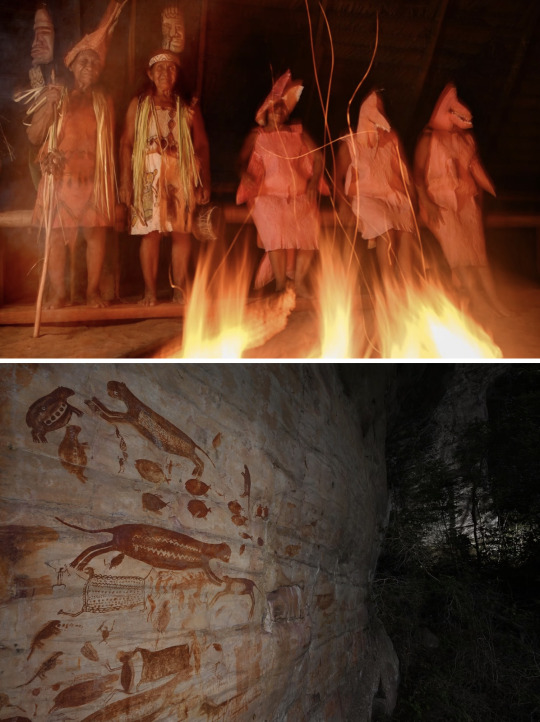
In the cosmology of the Tikuna, one of the largest Indigenous groups in the Amazon, pink dolphins are mischievous spirits and guardians of the watery realm. Elders Nuria Pinto and Pastora Guerrero join dancers wearing dolphin costumes made from the inner bark of the sapucaia tree. (Top)
Jaguars leap at pacas while piranhas swim on a panel known as “Hojarasca” (“Fallen Leaves”). More than 75,000 paintings have been discovered in Chiribiquete. Some are 20,000 years old, making them the most ancient rock art in the Americas. The pictographs show fauna and flora, people, and geometric patterns. Large jaguars and aquatic life are common motifs. (Bottom)
A few months ago, I photographed at my geographical starting point, the peak of Nevado Mismi in southwestern Peru, the farthest point from the Amazon’s mouth, where the waters flow uninterrupted all year. I’m in Chiribiquete to explore a different type of beginning and origin.
Here, the Amazon’s first storytellers painted the most ancient visual stories ever found in the Americas. More than 75,000 paintings have been discovered in more than 70 murals, cementing the park as the Louvre of rock art in the Americas. The pictographs include fauna and flora, people, and geometric patterns. Jaguars, sometimes life-size, are one of the most common motifs—each with a unique pattern of rosettes or lines.
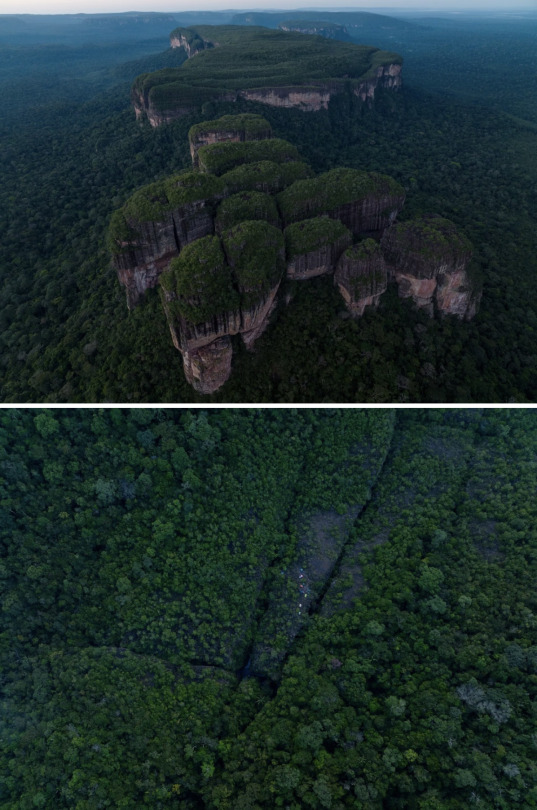
The ancient shaman artists chose the most spectacular locations to create their pictographs. The “Hojarasca” (“Fallen Leaves”) panel—the jaguars hunting pacas among piranhas—is located on the pillar at the far left, behind the one in the foreground. This expedition was only the ninth to be granted permission to explore the vast Chiribiquete National Park. (Top)
The expedition base camp was set up on a small patch of uneven rock that turns into a furnace during the day, with the solar-heated rock baking the air in the tents to more than 100 degrees Fahrenheit. The lack of shade and overwhelming number of sweat bees made the location nowhere near as idyllic as it first appeared. (Bottom)
I am with a small team, which includes aquatic biologist and National Geographic Explorer Fernando Trujillo and archaeologist Carlos Castaño-Uribe. A group of Colombian climbers and jungle specialists is with us so we don’t get lost in the trackless wilderness. We are only the ninth expedition to be granted permission to explore Colombia’s largest park, which protects a spectacular landscape of dense rainforest and soaring tabletop mountains called tepuis.
For 25 years I have documented our planet’s wildest seas, first as a marine biologist and later as a photojournalist. I am well versed in how not to get bitten by a shark or crushed by a feeding whale, but I am a neophyte in the jungle. In my defense, Chiribiquete is an incredibly difficult place to explore, and the ancient artists chose some of the most inaccessible locations.
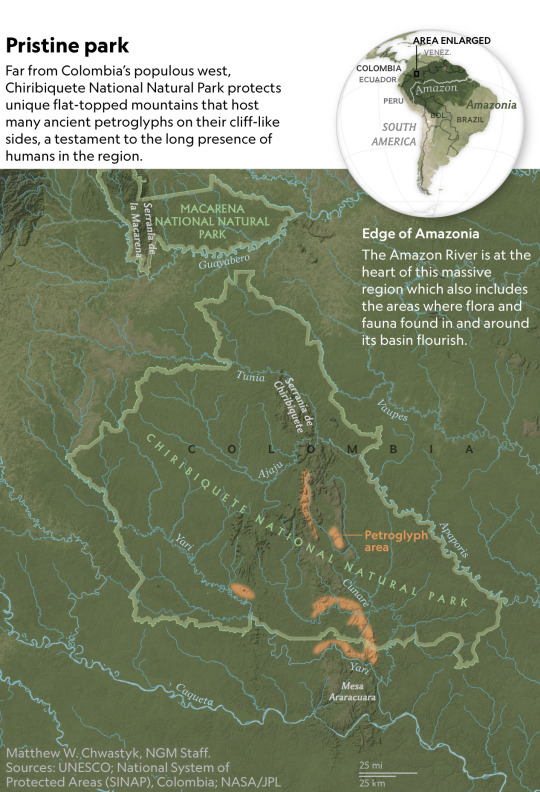
A Challenging Landscape
The helicopter takes off from the small airport of San José del Guaviare in south-central Colombia; the landscape below is a patchwork of cattle pastures and grasslands. Finally an unbroken carpet of pristine rainforest rolls out to the horizon. When the first mountains appear, the pilot descends, and we navigate through canyons so narrow that I can almost reach out and touch the cliffs. We land on a scrap of uneven rock. The helicopter barely fits.
The location appears idyllic, but it feels as if we’ve set up camp on a furnace. As the sun heats the rock, it bakes the air in our tents to more than 100 degrees Fahrenheit. I try to fall asleep, desperate for a breeze. My sweat forms wetlands on my mattress.
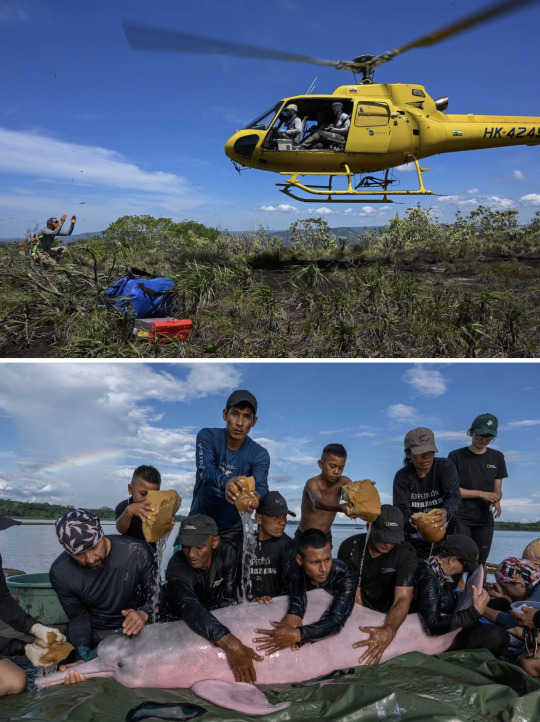
A helicopter is key to getting to and around Chiribiquete, as the terrain is extremely rugged and difficult to traverse on foot. To reach rock art painted in some of the most inaccessible places means rappelling down cliffs, bushwhacking through thick rainforest, and battling unrelenting bees. (Top)
National Geographic Explorer and scientist Fernando Trujillo (far left) and his team examine a boto, or pink dolphin, a keystone species in Amazonian rivers. Their assessments, which follow established safety protocols, provide critical information about the health of not only dolphin populations but also the rivers. (Bottom)
We wake to the sound of tens of thousands of tiny helicopters. The sweat bees are here. Soon the entire camp—camera cases, boots, clothing, plates, cutlery, anything left outside—is draped in bees. I make the mistake of leaving my tent zipper slightly cracked and before long end up with dozens of roommates. I let the bees quench their thirst from the sweat lake in my belly button. Resistance is futile. The bees overwhelm us. They crawl into our noses and ears; one even slips beneath my eyelid. A head net becomes mandatory.
The lowlands adjacent to rivers that flow through the park have hardly any sweat bees, but we were advised not to stay there. Remnants of FARC rebel forces are said to use these rivers when the water is high enough. I prefer bees to AK-47s.
Once, on an expedition in 2017, Trujillo woke in the early hours of the morning to the sound of footsteps. Thinking it was another researcher, he went back to sleep. The next morning, the scientists discovered smaller footprints, barefoot, in step with their boot prints. Indigenous Karijona, Murio, or Urumi people—uncontacted or living in isolation since violent encounters with rubber tappers in the 1800s—inhabit the headwaters of the park’s most important rivers. More than 50 miles of difficult terrain separate them from our campsite, but before falling asleep, I listen intently for the rustle of leaves or the crack of a twig.

Streams and rivers that flow from rocky plateaus run clear and are habitat for unique plants and animals. In the Serranía de la Macarena, a mountain range northwest of Chiribiquete, endemic Macarenia clavigera turns red in sunlight but remains green in shaded waterways. (Top)
A wolffish (Hoplias malabaricus) rests beneath a waterfall in the Caños Cristales River in the Serranía de la Macarena, obscured by a curtain of aerated water and camouflaged against a rocky ledge. This ambush predator waits for small schooling fish to swim within reach before lunging explosively and swallowing prey whole. (Bottom)
In the 1940s, Harvard ethnobotanist Richard Evans Schultes was the first scientist to note what he called Indian paintings on Chiribiquete’s cliffs. But he didn’t realize he was surrounded by one of the most extensive rock art repositories. This became apparent only in the 1980s when a storm pushed Castaño-Uribe’s Cessna off course and he spotted a mountain range that wasn’t on any of his maps. He returned to explore, saw the pictographs, and decided to devote his life to Chiribiquete. Not only did he publish the first detailed descriptions of the paintings and connect them to Indigenous cosmology, but he was also instrumental in the park’s establishment in 1989, expansions in 2013 and 2018, and selection as a UNESCO World Heritage site in 2018.
The oldest paintings here have been radiocarbon-dated to 20,000 years ago, but the youngest are from the 1970s, and compelling evidence shows that some are even more recent. On another expedition, Castaño-Uribe found a small hearth with animal bones and pigments beneath some paintings, indicating the art continues to be meaningful in Indigenous cosmology and ceremonial activities.
Hacking, Hiking, Rappelling
Before our expedition began, Castaño-Uribe consulted a shaman in the Sierra Nevada de Santa Marta, a mountain range near the Caribbean coast. To ensure a safe return and appease the spirits of the sites, the shaman advised him that we should make an offering of tobacco—sacred to many Amazonian Indigenous groups—before approaching the paintings. At the base of a sandstone tower, Castaño-Uribe passes around fat cigars that would not look out of place during a poker game. We puff vigorously, bathe ourselves in smoke, place our palms on the rock, and earnestly state our intentions. For extra measure, Castaño-Uribe exhales smoke over each of our heads.
Only then do we begin to explore.
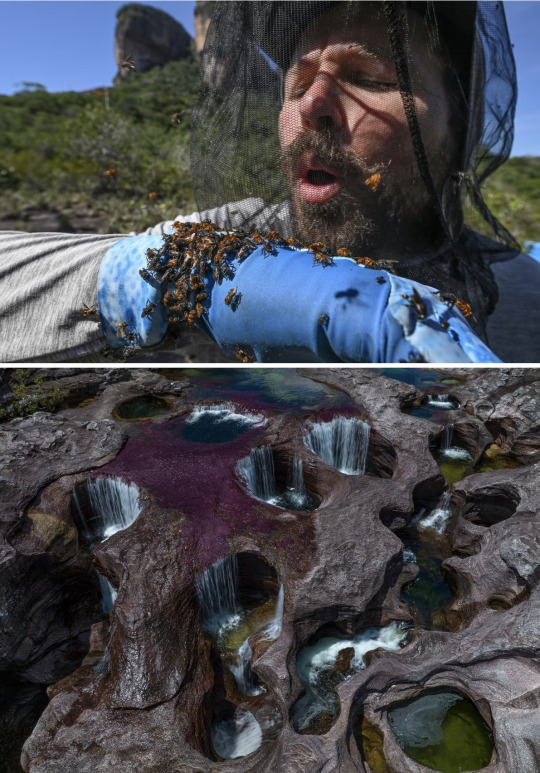
Sweat bees swarm videographer Otto Whitehead. Within minutes hundreds landed on him to lap up the nutrients and proteins in his perspiration. At least 11 species of the stingless bees abound on Chiribiquete’s tepuis. For this expedition a head net was essential gear. (Top)
The Caño Cristales carves these pits, known as giant’s kettles. They’re sculpted when hard pebbles fall into small cavities and are tumbled around by the current, over time scouring the cavity to form round pocks in the quartzite riverbed. (Bottom)
After hours of hacking through dense foliage, a dark canyon spits us out onto a narrow ledge next to a vertical cliff. We are at a site named “Los Gemelos” (“The Twins”). The rock art depicting stingrays, otters, and turtles is magnificent—and fiercely protected by bees. This time not the annoying stingless sweat bees but more virulent honeybees.
In less than half an hour the team collectively endures more than a hundred stings. We retreat, but the bees follow, and a rock wall that requires a fixed rope to climb becomes a bottleneck. Castaño-Uribe and I are waiting when he decides he has had enough of being stung. He bypasses the rope and, in a crouched run, scales the near-vertical 30-foot cliff, leaping from tree root to tree root, from branch to branch, Tarzan style. Not wanting to be left to the mercy of the belligerent bees, I follow, and despite being 15 years younger, I struggle to keep up.
Every morning we set out by helicopter and then on foot, climbing steep and densely forested slopes, rappelling down cliffs, and hauling ladders to navigate dark and damp canyons. Less than a half hour into one ascent I am close to collapsing because of my armored fashion choices. I’m layered up with thick combat pants, two shirts, gloves, a head net, and a pair of snakebite gaiters. I will do whatever it takes to protect myself from enemies, both real and imagined.
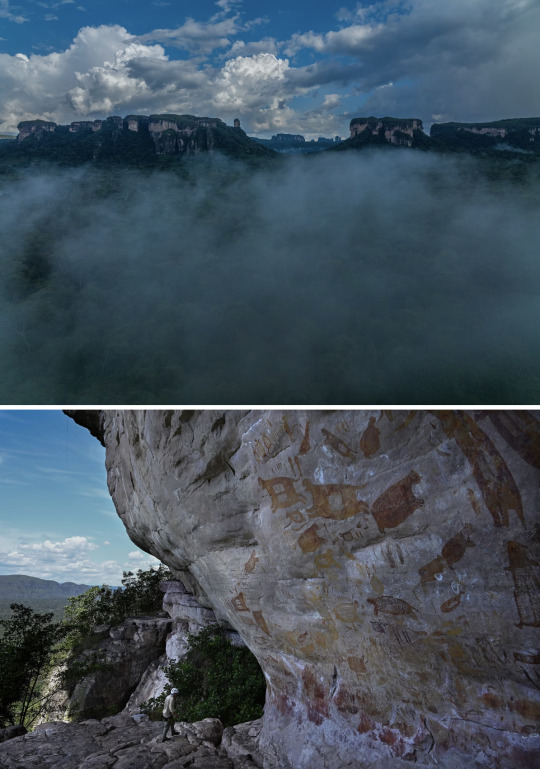
The park’s mountains soar from the rainforest floor, creating complex microclimates. Rising water vapor feeds the clouds, accelerating the formation of rain. More than half the precipitation in the Amazon stems from its own evaporation and transpiration. A fifth of the world’s fresh water is in the Amazon Basin. (Top)
Archaeologist Carlos Castaño-Uribe is dwarfed by a rock art panel named “Los Gemelos” (“The Twins”). These pictographs of jaguars, otters, stingrays, and turtles are stunning—and fiercely protected by honeybees. After enduring more than a hundred stings, the expedition team abandoned this site in a hurry. (Bottom)
The ferocious sting of bullet ants, a whopping 4 on the Schmidt pain index, is described as akin to walking across hot coals with a three-inch nail embedded in your heel. The potentially lethal fer-de-lance is responsible for most of the snakebites in the Amazon region. The bite of a female phlebotomine sand fly could infect me with disfiguring leishmaniasis. With every labored step in the stifling heat, I ask myself again and again what I’m doing in the Amazon.
I remind myself that this is just one chapter in my journey. Soon I will be back in my element, underwater, photographing species that are so outlandish that they could have been extras at the Star Wars cantina. Pink dolphins use sonar to navigate flooded woodlands. The arapaima, an armored fish that weighs as much as a silverback gorilla, leaps from the water like a marlin. Electric eels, like swimming batteries, deliver 600-volt shocks powerful enough to kill a human. Black freshwater stingrays with bright yellow spots rest in the leaf litter of drowned forest floors.
My National Geographic Explorer collaborators include some of the Amazon’s most accomplished scientists: Fernando Trujillo, João Campos-Silva, Ruthmery Pillco Huarcaya, Angelo Bernardino, Thiago Silva, Baker Perry, and Hinsby Cadillo-Quiroz. They’re doing groundbreaking work on pink dolphins, arapaimas, spectacled bears, mangroves, flooded forests, climate change, and mercury pollution. Next year, National Geographic will devote an entire issue of the magazine to the Amazon, featuring my photographs and their studies.
Finding Inspiration From the Earliest Amazon Artists
Famed 19th-century naturalists like Henry Walter Bates, Alfred Russel Wallace, and Alexander von Humboldt produced beautiful illustrations of what they had seen on their explorations in the Amazon River Basin. But I came to Chiribiquete to see the work of the first people in the Amazon to depict fauna and flora, specifically the aquatic animals I hope to photograph. On sheer rock walls, they painted fish, turtles, caimans, and other life-forms.
Over our five days in Chiribiquete, we saw hundreds of pictographs. The “Hojarasca” (“Fallen Leaves”) panel, with jaguars hunting pacas among piranhas, spoke to me the most. The way they’re painted on an overhang evoked the sense that I was underwater looking up as the scene played out above.

Lowland tapirs eat aquatic plants and walk underwater as hippos do. Juveniles have stripes and spots that help camouflage them. This one is a rescued orphan that will be rewilded. In between feedings, it’s free to explore forests and scrublands on a cattle ranch in the Serranía de la Macarena.
Castaño-Uribe thinks these paintings were likely made by shamans and played a role in religious rituals. Through the ingestion of sacred plants, Baniwa shamans believe they can transform into jaguars and talk with spirits. To the Tikuna, pink dolphins are sacred, feature in their dances, and are said to dwell in malocas, or longhouses, at the bottom of the river. Anacondas are often considered the creators of the universe, and a Desano legend tells of a giant snake that ascended the Amazon carrying the ancestors of all mankind on its back.
The shamans likely painted to communicate with supernatural beings to ensure balance between humans and the rest of nature. I tell stories because our relationship with Earth’s biodiversity urgently needs recalibration. The Amazon’s aquatic world is threatened by dams, mining, overfishing, pollution, and climate change. Gazing at these vivid, timeless pictures, I feel deeply connected to these artists and their paintings. I realize we are telling similar stories, and I hope my images stand the test of time even a fraction as well as theirs.
1 note
·
View note
Text
Section 5 / Continent: North America
General Layout:
Section 5 is comprised of open plains, dense forests, and winding rivers. It has few enclosures and even fewer indoor exhibits.
The section is marked with pathways and hiking trails, guests can also get around the section riding on horseback, ziplines, and boats.
Along with the section's restaurants, gift shops, and amenities, there's also a carnival with a rodeo and circus, workshops, and guided nature walks.
The Animals:
Amphibians: Frogs and Salamanders.
Aquatic/Semi-Aquatic Mammals: Dolphin, Manatees, Otters, Porpoises, Sea Lions, Seals, Walruses, and Whales.
Birds: Blue Jays, Bluebirds, Cardinals, Chickadees, Crow, Dove, Ducks, Eagles, Egrets, Finches, Geese, Gull, Hawks, Herons, Hummingbirds, Magpies, Mockingbirds, Ospreys, Owls, Pelicans, Quail, Robins, Sparrows, Turkeys, Turkey Vultures, Warblers, and Woodpeckers.
Fish: Bass, Carp, Catfish, Mola, Perch, Seahorses, Sharks, and Trout.
Insects: Ants, Beetles, Bees, Butterflies, Dragonflies, Grasshopper, and Moths.
Misc. Carnivores Animals: Anteater, Armadillos, Badgers, Bats, Bobcats, Coyotes, Ferrets, Grisons, Jaguars, Jaguarundis, Lynxes, Margays, Minks, Moles, Mountain Lions, Ocelots, Oncillas, Weasels, Wolverine, and Wolves.
Misc. Herbivorous Animals: Bats, Beavers, Bison, Deer, Goats, Gophers, Ground Squirrels, Groundhogs, Hares, Kinkajous, Marmots, Muskoxen, Olingos, Pacas, Pikas, Porcupines, Prairie Dog, Pronghorn, Rabbits, Sheep, Sloths, and Tapirs.
Misc. Omnivorous Animals: Bears, Cacomistle, Chipmunks, Coatis, Flying Squirrels, Foxes, Mice, Opossums, Peccaries, Raccoons, Rats, Shrew, Skunks, Squirrels, and Tayras.
Primates: Capuchins, Howler Monkeys, Panamanian Night Monkeys, Spider Monkeys, and Tamarins.
Reptiles: Alligators, Crocodiles, Lizards, Snakes, and Turtles.
#the butterfly's effect#notes#writers on tumblr#current wip#writeblr#writblr#writing#wip#work in progress#zoo#wildlife#north american wildlife#american animals#american wildlife#american fauna
1 note
·
View note